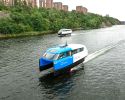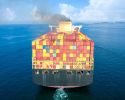Water Flooding Systems in Battery Packs Offer the Best Fire Protection for Smaller Electric Ferries

According to a new preliminary study from Lighthouse and the Swedish Transport Administration (Trafikverket), water flooding systems – capable of spraying water directly into battery packs – are preferable to traditional sprinkler systems on smaller electric ferries. A targeted water flow provides significantly better cooling performance and reduces the risk of fire spreading.
Lithium-ion batteries are becoming increasingly common in smaller electric vessels. This brings new safety challenges, particularly in terms of fire risk. These vessels, often under 15 meters in length, have limited space, making it more difficult to implement safe solutions for batteries placed in small, confined areas. Additionally, electric vessels are built to be as lightweight as possible to maximize range, which often means they are constructed using materials that are sensitive to high temperatures.
“There is simply no room for traditional sprinkler systems, which also require fresh water that adds considerable weight. New solutions and tailored regulations are therefore needed to manage fire risks in the next generation of smaller electric vessels,” says Payam Kalantar from DNV, one of the authors of the preliminary study BattFiSafe23, conducted within the Swedish Transport Administration’s industry program Sustainable Shipping, coordinated by Lighthouse.
The report, based on literature studies and a workshop, concludes that water flooding systems are considered a more effective solution for extinguishing fires in confined battery spaces onboard – especially if they are designed to flow water directly into the battery packs. Flooding systems that are only connected to the battery casing are less effective in the event of external fires, as they do not cool as efficiently.
One proposed solution in the report is to encase the battery in an open-top boxes. This design can reduce the amount of water needed to flood the battery compartment while also helping to prevent internal fire spread. However, limited water availability must not compromise onboard safety – the extinguishing time must be matched to the vessel’s evacuation capacity and specific operational conditions.
“The next step is to test this in practice. We need to ensure that the system works as intended, and that the extinguishing time is adequate in relation to the vessel’s evacuation time and operational conditions,” says Payam Kalantar.
There is strong industry interest in the issue, and work is currently underway on a new project application to take the development further.
The report BattFiSafe23 – Developing battery fire safety requirements suitable for smaller EES spaces onboard was authored by Kristoffer Uulas and Payam Kalantar (DNV), Marcus Höjgaard, Magnus Arvidsson, and Anna Karlsson (RISE).
-
 NextWave – en podd som ska locka unga
NextWave – en podd som ska locka unga -
 Ny studie: Eldrivna pendelbåtar kan effektivisera Stockholms kollektivtrafik
Ny studie: Eldrivna pendelbåtar kan effektivisera Stockholms kollektivtrafik -
 Sjöfartens utsläpp ökar
Sjöfartens utsläpp ökar -
 Sociala relationer påverkar val av bränsle
Sociala relationer påverkar val av bränsle -
 Sjöfartens omställning kräver ”mjukare” påtryckningar
Sjöfartens omställning kräver ”mjukare” påtryckningar -
 Hon hade avtalad tid med Kapten ynkrygg
Hon hade avtalad tid med Kapten ynkrygg -
 Lighthouse omvärldsanalys 2025 – osäkerhet och tullar präglar sjöfarten
Lighthouse omvärldsanalys 2025 – osäkerhet och tullar präglar sjöfarten -
 Se seminariet Shipping in the Marine Environment
Se seminariet Shipping in the Marine Environment -
 Vad betyder egentligen de 90 procenten?
Vad betyder egentligen de 90 procenten? -
 Hålla där...
Hålla där...

